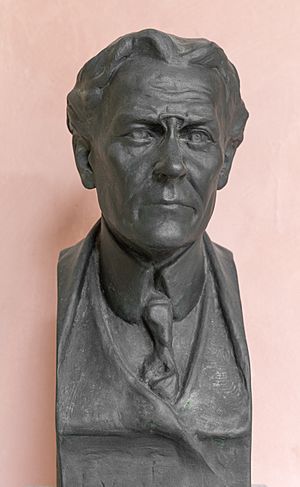Julius von Schlosser facts for kids
Julius von Schlosser was a very important Austrian art historian. An art historian studies the history of art, including paintings, sculptures, and buildings. He was a key member of the Vienna School of Art History, a group of scholars who studied art in a special way in Vienna. A famous art historian named Ernst Gombrich called him "one of the most distinguished personalities of art history."
Life and Work of Julius von Schlosser
Julius Schlosser was born in Vienna in 1866. He studied many subjects at the University of Vienna from 1884 to 1887. These subjects included philology (the study of language), art history, and archaeology (the study of ancient cultures).
In 1888, he earned his Ph.D. with a paper about old medieval cloisters (covered walkways in monasteries). He became a professor and director of the sculpture collection in Vienna in 1901. In 1913, he was given the title of "Ritter" (knight), and his name changed to Julius von Schlosser. He also became a member of the Austrian Academy of Sciences in 1919.
After another art historian, Max Dvořák, passed away in 1922, Julius von Schlosser took charge of one of the art history departments at the University of Vienna. He retired in 1936 and passed away in 1938.
Important Writings
Julius von Schlosser wrote many important books and studies about art history.
- In 1908, he published a book called Die Kunst- und Wunderkammern der Spätrenaissance. This book was about "cabinets of curiosities" or "wonder rooms" from the late Renaissance period. These were special rooms where people collected interesting objects like art, natural specimens, and scientific tools.
- He also studied the writings of Lorenzo Ghiberti, a famous Italian artist from the Renaissance.
- From 1914 to 1920, he wrote an eight-part series called Materialien zur Quellenkunde der Kunstgeschichte. This was a collection of sources for understanding art history.
- In 1923, he wrote about medieval art in his book Die Kunst des Mittelalters.
- One of his most famous works is Die Kunstliteratur, published in 1924. This book is a huge list and guide to writings about art from ancient times up to the 18th century. It has been translated into Italian and French. Many people still use it today as an important reference book.
- He also wrote a three-volume work about artists in the early Renaissance.
- In 1934, he wrote about Die Wiener Schule der Kunstgeschichte (The Vienna School of Art History).
- Besides art history, he also published a book about the history of musical instruments in 1922.
Julius von Schlosser's mother was Italian, so he spoke Italian very well. He wanted his students to read original Italian texts, especially those by Vasari, another important Italian art historian. He was also a close friend of Benedetto Croce, a famous Italian philosopher, and translated some of Croce's works into German.
Many experts agree that Julius von Schlosser was one of the most important art historians of the 20th century. He was known for his wide knowledge, not just in art, but also in literature, history, and music. He didn't like to be a "specialist" in just one small area.
Famous Students
Many of Julius von Schlosser's students became well-known art historians themselves. Some of them include Ernst Kris, Otto Kurz, Ernst Gombrich, Otto Pächt, Hans Sedlmayr, Fritz Saxl, Ludwig Goldscheider, and Charles de Tolnay.
A street in Vienna, called Schlossergasse, was named in his honor.
See also
 In Spanish: Julius von Schlosser para niños
In Spanish: Julius von Schlosser para niños


